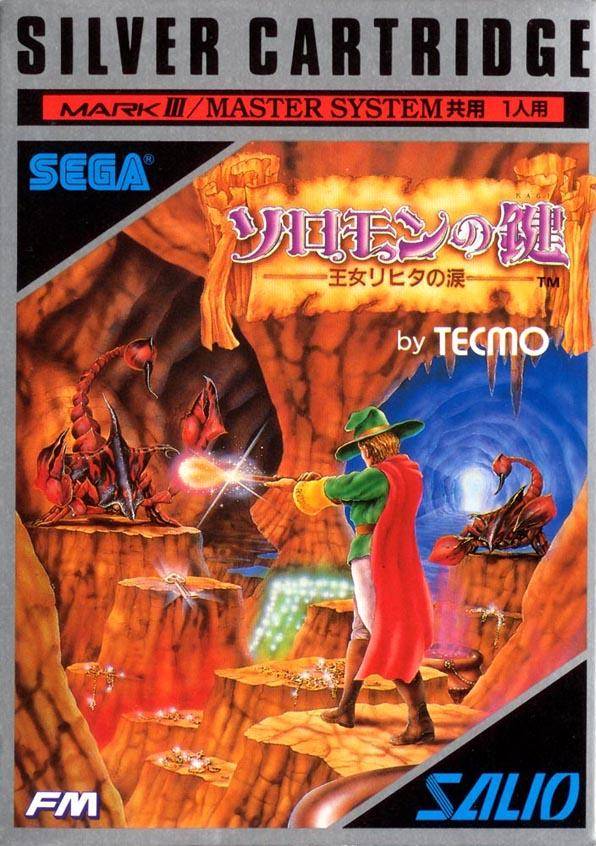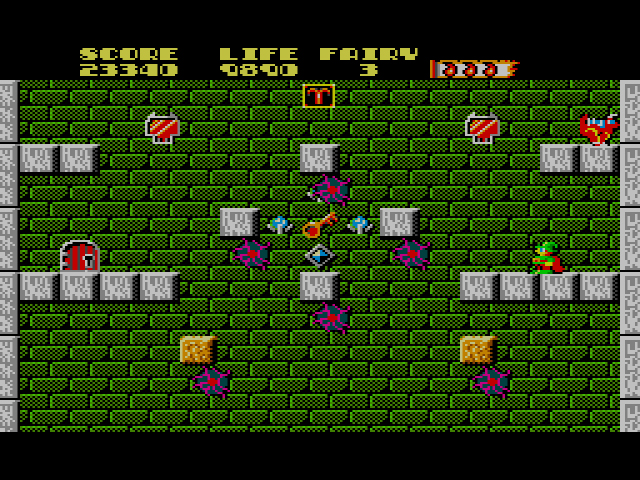
PLAYERS: 1
PUBLISHER: Salio
DEVELOPER: Tecmo (port by Salio)
GENRE: Puzzle/Arcade
RELEASE DATE: 04/17/88 – (JP)
Solomon no Kagi: Oujo Rihita no Namida translates to Solomon’s Key: Princess Rihita’s Tears. Such a sad subtitle. I’d like to think the captive Princess Rihita is crying on the behalf of those who’ve ventured into the game’s fifty maddening rooms. Solomon’s Key – which has been released for the arcade, the NES, PC, and about a half-dozen other platforms – is one of the most devious puzzle platformers of the last thirty years and will likely make you leak some ocular fluid of your own. I still agree with this quote from my NES review*: “At its best, completing a challenging level will make you feel like you’ve climbed the gaming version of Everest. But when you replay the same level fifty-plus times with no solution in sight, ripping one’s chest hair and copious mourning are the only reasonable courses of action. Play with caution.” If not for yourself, then for Princess Rihita and her poor red eyes.
![Solomon no Kagi - Oujo Rihita no Namida (J) [!]002](https://segadoes.com/wp-content/uploads/2015/05/solomon-no-kagi-oujo-rihita-no-namida-j-002.jpg?w=300)
You play as a wizard, Dana, and you’re tasked with sealing the book known as “Solomon’s Key” and restoring peace and hope to the universe. You do this by stepping into a forbidden realm known as the “Constellation Space,” a set of fifty rooms that have special items to collect, puzzles to overcome, and enemies to destroy. Once Dana grabs the key in each room, the exit will open and he’ll move on to the next.
![Solomon no Kagi - Oujo Rihita no Namida (J) [!]000](https://segadoes.com/wp-content/uploads/2015/05/solomon-no-kagi-oujo-rihita-no-namida-j-000.jpg?w=300)
Unlike some of history’s most powerful wizards – Gandalf, Merlin, Sir Alec Guinness – Dana can only create and destroy blocks with his wand, nothing else. Thankfully, this power is exactly what he needs to make his way through the Constellation Space and find Solomon’s Key. Blocks can be used to build stairs, create barriers, trap enemies. Simultaneously, blocks can be destroyed to release enemies, create a path through barriers, and, er, dismantle stairs. Blocks will be your one friend on this hard, cruel journey. I should clarify: Dana does have other abilities besides block-building/destroying. He can jump, hobble along, and if he finds and collects fire pots, shoot a fireball out of his wand to destroy an enemy. All in all, though, he’s not among Hogwarts’ Best and Brightest.
![Solomon no Kagi - Oujo Rihita no Namida (J) [!]003](https://segadoes.com/wp-content/uploads/2015/05/solomon-no-kagi-oujo-rihita-no-namida-j-003.jpg?w=300)
But land sakes, is Solomon no Kagi hard. You see these screenshots? They’re from level seven or before (I couldn’t get past level seven because my mind does not work that way). The game might have fifty levels, but it really wants to give you a brain-busting right off the bat. The levels would be more doable methinks, if not for the time limit. In levels where you need to ponder for a minute, you can’t. You don’t have a minute. Figure out which blocks go where now, you big wizard baby. To be fair, if you spend your measly three Danas and get a game over, you can continue from the level that was giving you trouble. But if you continue, you lose your items, your high score, your self-esteem, and brother, those are hard to get back.
![Solomon no Kagi - Oujo Rihita no Namida (J) [!]001](https://segadoes.com/wp-content/uploads/2015/05/solomon-no-kagi-oujo-rihita-no-namida-j-001.jpg?w=300)
Solomon no Kagi is a heroic ball-buster of a challenge, but it is fair. When I fail to build a block in the proper space or move away from an enemy barreling down on me, this is my fault, not the game’s. The game’s stealthy secrets – like the items that won’t appear unless you build and destroy a block on a specific space – and multiple endings that vary depending on how many hidden rooms you find add replay value to a game that already gives you fifty-plus levels to begin with. Solomon no Kagi won’t force everyone into willful submission, but for those eager to embrace pain and pleasure in equal portions, Princess Rihita’s tears will more than satisfy.
B
*I prefer the NES version over the Master System version, if only for the slightly more responsive controls. Assigning jump to ‘Up’ on the D-pad is always a terrible idea, regardless of console, but in the Master System version, Dana sticks a little when jumping. Since Solomon no Kagi often requires precise movement and timing, any sticking can potentially lead to unwarranted death.


9 replies on “Solomon no Kagi… (Master System, 1988)”
“But if you continue, you lose your items, your high score, your self-esteem, and brother, those are hard to get back.”
Hahahahah you rock man.
If only the game was more like the box art. “Solomon’s Key: Giant Mutant Scorpion’s Tears” has a nice ring to it.
This is one of the very very few titles that shared a release on the NES and SMS. You know what I find refreshing! That there is very little crossover between titles. Both systems for the most part have a unique library. You don’t really see that much anymore.It is mostly the same games with an exclusive here or their. At least the NES and SMS had their own identity. And often games that appeared on both were quite a bit different.well not this game.
Got to agree with you there Sean
I also think the NES version is better if you put them side by side. But in the end I like them both and think this is a good game either way!
The way that review was going I was surprised by the high grade
Gotta keep you on your toes, Tony!
Do you know the difference or reasons between the gold label and silver label Mark III games ?
Are silver label third party games ?
I believe the silver labels only appeared on games by Taito, but I’m not 100% on that.